#2 NW Front Street
Coupeville, Washington
Puget Race Drug Store / Old Town Shop / Aqua Gifts
1890 - The building was constructed.
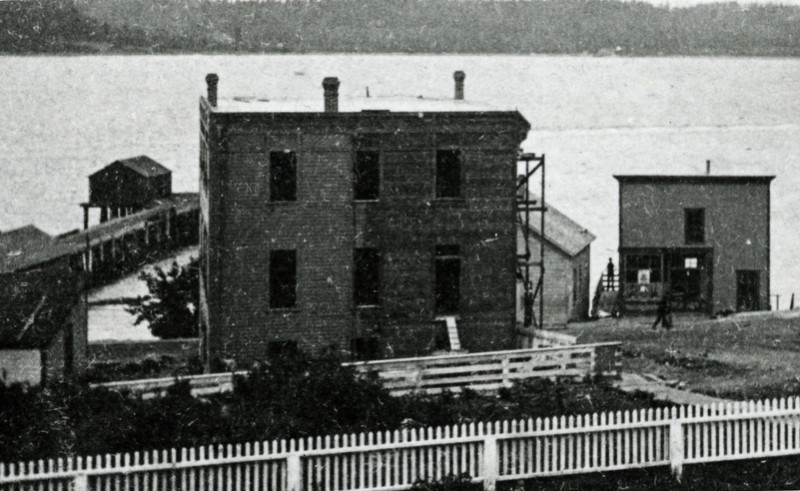
F. Puget Race Drugstore, 1890
The building to the right of the Glenwood Hotel under construction.
Courtesy: Historic Whidbey
Quote from the Ebey's Landing Building Inventory, 1983
This building was constructed in 1890 for the F. Puget Race Drug Store. The lower part of the building was occupied by Will Tenney, a shoemaker. The Drug Store occupied the building for many years and later it was rented as an apartment. Since the 1960's, the building has been operated as the Old Town Shop. The south facade of the building has been altered over the years with an entrance on the east facade replaced by windows, and the awning added to the south facade.
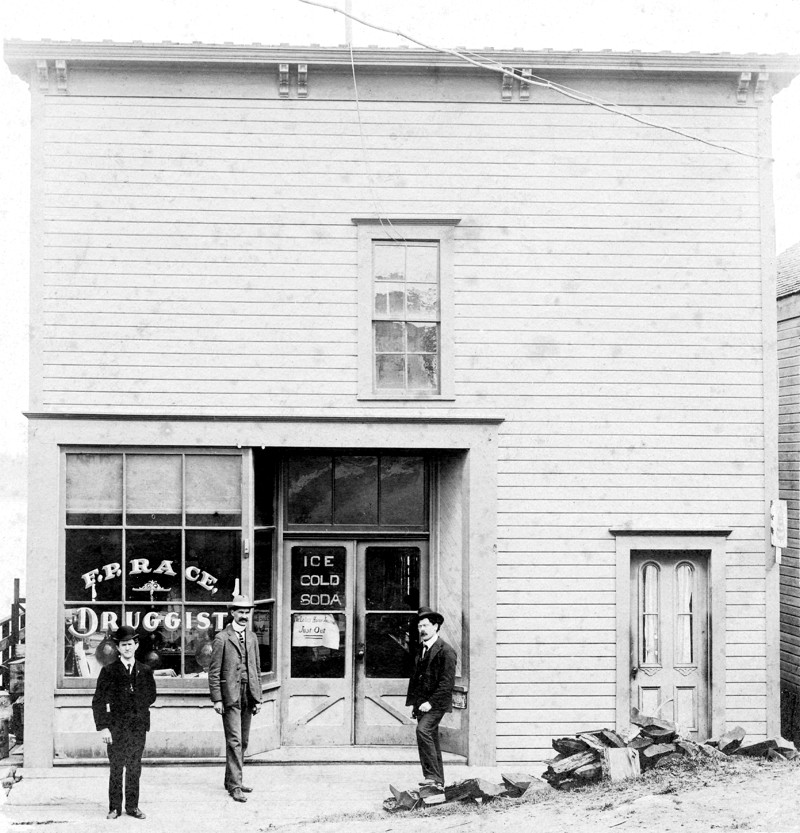
F. Puget Race Drugstore
Note that the Furniture Warehouse had been constructed on the right by this time. The telephone exchange had not been added on the left.
Courtesy: Island County Historical Museum, Coupeville
Quote from "A Particular Friend, PENN'S COVE" by Jimmie Jean Cook
FRANCIS PUGET RACE
"Mr. F. Puget Race combines the duties of a real estate and insurance agent with that of running a fine drug store. He is a successful business man and is one of Coupeville's most earnest workers." Puget was the son of Henry and Frances Race who came to Whidbey Island in 1876 after living at Port Gamble. Henry came as supercargo from Australia and his association with that country is evident from the names given his children: Henry Melbourne, Tasman (Tasmania), Austral, William Hobart (Hobarttown), Francis Puget (named by Cyrus Walker of Puget Mill Co.) and .... Ronald.
Ronnie Race was a splendid man with a handsome white moustache who in his later years helped Ralph Lindsay at his grocery store. He was able to witch water and is credited with locating the town well, which may not have the best water but has never had a lack of it.
The Races bought the Reuben Doyle farmhouse on what is now known as Race's Lagoon. This sturdy house was built in the sixties and through neglect and vandalism, is almost destroyed.
Puget joined Dr. Highwarden at his drug store in 1887 and learned the drug business. When Washington became a state, doctors and druggists were allowed to continue under the preceptor system that registered all territorial practitioners.
In 1889 Mrs. Frances Race purchased this property from Daniel Pearson and Puget dissolved his partnership with Highwarden, entering into business for himself. According to his son, Dr. Will Race, this drug store was the only one between Seattle and Bellingham except for one at LaConner. There were many logging camps in the area and the need for drugs was great.
On August 2, 1890, he married Hattie W. Swift, daughter of Captain and Emily Swift. Puget had been previously living in the upper part of Gaston's store building when the county road crew sheared through the building. He came home to find his room quite exposed and a move to new quarters seemed advisable.
Puget was the druggist in Coupeville for many years. The sign on the water side of this building advertising the business is still visible. Will Tenney was a shoemaker who worked in the lower part of the building and who also cleaned and repaired guns and sewing machines.
In the small part of the building between the drug store and the Sedge building was the telephone office. Ruby Pennington (Operator No. 7) was a main operator (there were two) and others were Dora Pennington, Henrietta and Doris Capaan, Della Evans, and Dorothy Myers.
The line went through Anacortes to Seattle and was a drop switchboard; the person who monopolized the line could be, if necessary, effectively cut off by dropping the switch.
Mr. Adamson of Oak Harbor was the manager for both Coupeville and Oak Harbor. Ruby remembers that two of her more considerate customers were Sheriff Gil Kennedy and Mr. Frank Pratt. She also remembers the number that impressed her then as a young woman--the Fort Casey line was 202.
After the Race Drug Co. was gone, the smaller part of the building was used by Mr. and Mrs. B. J.
Francis who ran a small drug store. They were English and after his death, she kept a few supplies on hand. Finally the building was rented out as an apartment by Hattie Race.
1920s - A telephone exchange was inserted into the gap between #2 and #4. There were two operators. Later the exchange was moved to Coveland St.
1930s - Mr. and Mrs. Francis ran their drug store after Race Drug Co was gone. After that it became an dwelling. Mike Andrews, a teacher, lived there in the late sixties.
1969 - Holace Perry and Mickey Becker purchased #2 and #4. The set up and ran the Old Town Shop in #2. They lived upstairs. They sold #4 to D Kroon in 1975 for Kneed and Feed.
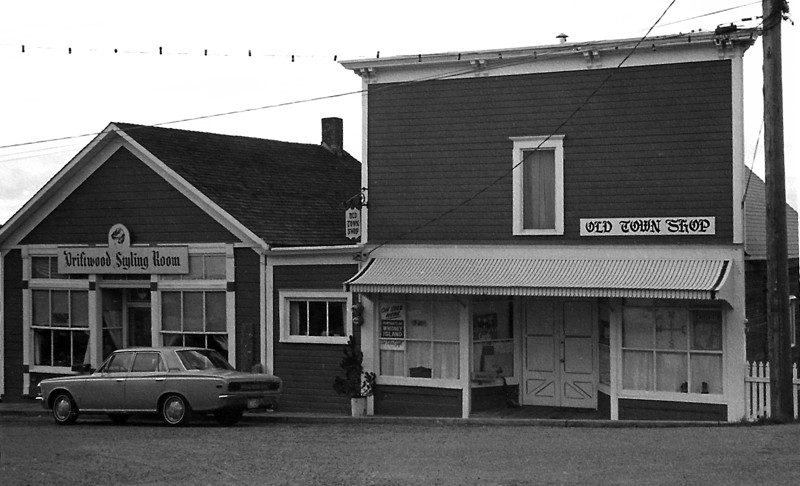
Old Town Shop
Note that the gap between #2 and #4 has now been filled in - it was originally filled to be used for a telephone exchange and then later for storage.
Courtesy: Island County Historical Museum, Coupeville
1986 - Holace Perry and Mickey Becker sold the building to Judy King. John Fielding ran the Old Town Shop.
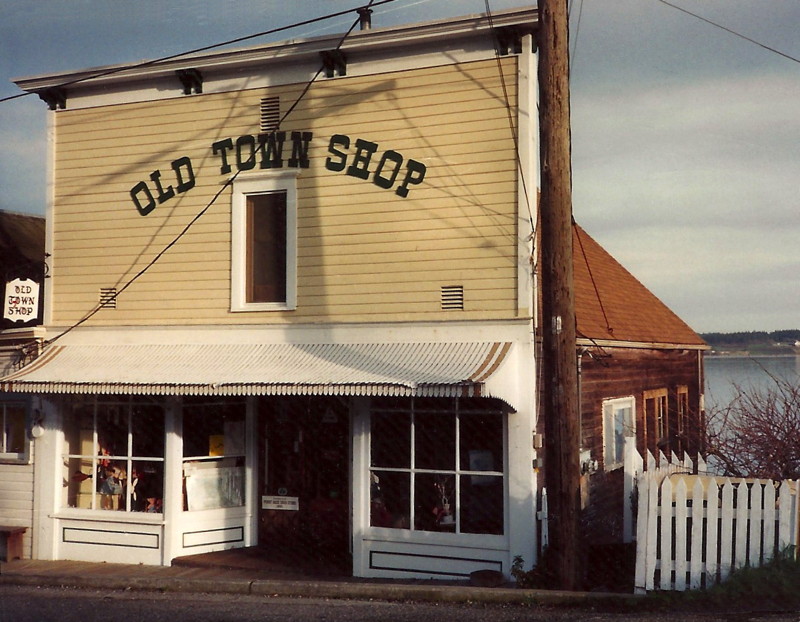
Old Town Shop
Courtesy: Island County Historical Museum, Coupeville
2003 - Brenda's Gift Gallery was run by Brenda Marti. She expanded to downstairs with tea & coffee.
2004 - Seaside Garden Shed run by Cindy Olson.
2008 - Aqua Gift Shop opened by Cindy Olson.
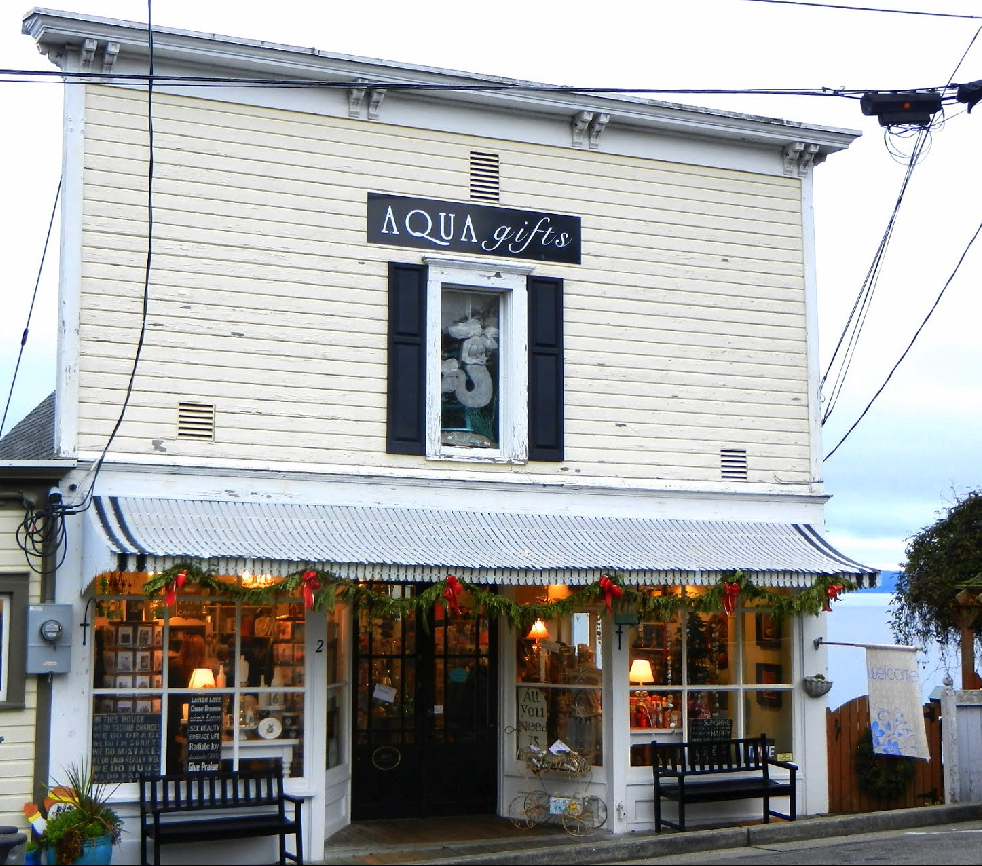
Aqua Gifts
Courtesy: Midnight Rider at the Panoramio website
*Interview by Judy Lynn with Judy King, 2008:
Judy L: How did you happen to buy the Old Town Shop
Judy K: Holace Perry and Mickey Becker were close to retirement and put the business on the market. I was changing careers. I had never been in a shop business and thought it would be interesting.
I knew them because I had been in the shop many times and decided to talk to them about it. They invited me to lunch. We sat on a little tiny bench upstairs, overlooking Penn Cove, and had tea and home made cookies. They thought I would be a good prospect. They liked what I had done in the past and where I was in the community. They had a right to choose who they wanted to buy it. In a couple of weeks they made a decision and I got to buy this place. They stayed with me for two weeks to teach me, and said they would be in background if I had problems. We made the transition and it was real successful. I don’t know if they stayed in town. They were pretty close at hand, at least for a month or two.
I bought The Old Town Shop in 1986 and kept the name.
When I took over the shop the town wanted me to take over all they were doing too. They also owned the lot east of the Old Town Shop and I bought that lot too. I had an option to buy within 5 years. This is the dividing line between residential and commercial zoning. The Old Town Shop is commercial and the lot to the East is residential.
Taking over [from Holace and Mickey] was big order. They went to every city hall and historical meeting. I was supposed to do that in the morning and get back to the business and open it. It was a tall order. I tapped in a little bit but I couldn’t do it all. (There were two of them.) I did sweep the streets. We still do that. Everybody on Front Street gets out there and get the streets clean. The city doesn’t always do it.
Judy L: What were you doing before?
Judy K: I’d raised my children and was going through a divorce. I had a retail business, a gift shop at 504 N Main.
Judy L: Did you live in that house?
Judy K: No, there were attorney’s offices. Mr. Bailey was an Attorney that rented. I was living at Ledgewood Beach.
Judy L: When you bought the shop where did you live?
Judy K: I lived here like Holace and Mickey had, upstairs and down. There is a kitchen in the upstairs and there is still a sink there. I still have an apartment stove that still works there. The upstairs was living quarters and later it was extended as retail. I moved downstairs and used the first floor bathroom. There is a bathtub on both floors.
When I decided to retire I wanted to convert the downstairs but had to have a bathroom. I had someone dig into the bank (under the shop). It took six months to do the hand digging. I had to reinforce the whole bank to get a little bathroom. It took over a year. I rented out the upstairs as another retail space.
I retired in 2003. I had a liquidation sale and we moved everything out in two days. Another gal (Brenda Marti) bought several display pieces. She moved in while I was moving out. She chose her own name: Brenda’s Gifts. I was in business 18 years.
Holace and Mickey rented this building to an artist before they moved up here. Betty Frost and her husband, Wes Broton. They were both artists. They did portraits in ink drawings.
I bought the inventory from them even though it wasn’t my style. I changed to country style but I kept the cards. People came from Canada and all over. The shop had a reputation for candy sticks. Everybody expected cards and candy sticks. The candy display was right inside the door. Sometimes it took 20 minutes for them to select a handful of them. It was a treat.
Judy L: What other changes did you make?
Judy K: In merchandise it was more primitive and country. They had more art. I made it more my taste and flavor. It took a couple of years.
Holace had everything a certain way. If a table was moved six inches Holace would move it back. I would see them twice a year. They would check in to see how it was going. They had a real sense of community and friendship. They always came for the (Coupeville Arts and Crafts) festival. They would always buy two or three cards.
After Holace and Mickey left Coupeville they moved to Horizon House in Seattle. They operated the thrift shop there. It grew from one room to a whole floor. They were very organized, very into everything. Always helping everybody. If there was a need they would find a way to fix it.
Judy L: What were your favorite things about the business?
Judy K: The relationship with the community and customers. It was like a family business, not like going into a strange town. Holace and Mickey had information to give to everybody. They were like the Chamber of Commerce. If someone needed an answer, they heard, “Ask the gall at the end of the street.” When I inherited the business I inherited the history. It was always social. People were coming down from Canada, and they would remember and tell tales.
I received a letter and the only address was “The Old Town Shop.” Everybody knew everybody. That was the social part. People came in and asked if we could get a certain item and they would come back and we had it. It was consistent. Mostly the people are the best memories—their stories. The town was working together. Everybody was working together. This was the core of the town.
Judy L: Who do you remember as other business owners?
Judy K: The McPherson’s candy store [Glenwood Hotel] was owned by Jack McPherson. They had an Easter bunny 5 feet high. They would chop it down after Easter and the kids waited for that.
The Knead and Feed (Sedge Building) was always here. You could smell the rolls – the aroma would go up and down the street. They were the biggest rolls on the island.
This N That (Sedge Building) was next door. The owner, Ardell Kuckenbecker was quiet and sweet. Later Tartans and Tweeds, owned by Katie Zimmerman and Carol Amtmann moved into where the This N That had been. We would sit out on the step and hash over activities when it got slow.
v
Millie Fonda took over the antique store [Coupeville Cash Store]. They got traffic from both ends of town and were a great anchor.
Betty McPhee [Trader’s Wharf in Terry’s Dryer building] was a character and a half. She could sell you anything. You had to rummage through everything. She was always fun. I don’t remember her sweeping the street. She left after I bought the business. I didn’t remember her being outside. She traveled and brought things back to sell.
The Honey Bear was owned by Virigina Lehr. It was a candy store and carried kids stuff.
The owner of Toby’s was Hank Tabach. They were the first ones I met when I moved to the Island, Hank and (his wife) Glynes. They were friends of the (Tom) Coupe’s. We met them at the Greenbank store. We would play cards and have a beer. We took the kids to the beach.
Judy L: How did you come to Whidbey?
Judy K: I was raised in eastern Washington and I married a sailor. We raised our kids here. I moved here in 1967 and been here ever since.
Judy L: What can you tell me about the [Puget Race Drug Store] building?
Judy K: We haven’t done too much. It has basically stayed the same. We never painted it except for the front. It is post and beam construction. Anything done on the inside was done before I moved here, except for adding the downstairs bath.
Judy L: What do you know about the space in between the two shops?
Judy K: It must have had a door. It’s a 6’ space the length of the building. It belongs to Kneed and Feed. It’s their way to get into their bathroom. At one time I think this space was a telephone office. [Note: it was the first telephone office in Coupeville. The entrance was through the Sedge building.]
Judy L: I have seen a sign permit for “John Fielding Gallery” in May 1986. What can you tell me about that?
Judy K: I carried John’s paintings for 2 to 3 years and he taught watercolor. He needed to have his own studio so he was invited to be downstairs at no cost as long as he was there every day. He did it for a year but he was shy, not a people person. He didn’t sell more work downstairs but people loved to watch him paint. He left because he needed more time and privacy to paint well.
Judy L: Who have been other owners of businesses in this building?
Judy K: Cindy Olsen had a coffee shop downstairs. Then when Brenda Marti moved out upstairs Cindy moved upstairs. I’ve never had it vacant.
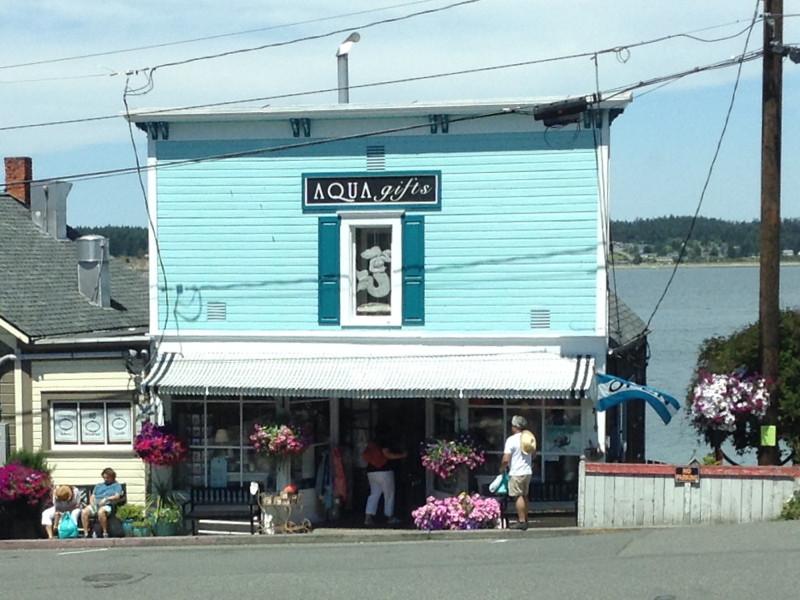
Aqua Gifts with its aqua paint, 2014
Courtesy: Robert Y Elphick - 2014
2015 Aqua Gifts sold to Christian Chambers. Cindy Olson retires.
* All the interviews are extracted from the Judy Lynn's Oral History Project. Judy Lynn interviewed everyone she could find who had any memories of the history of Front Street. For more information on the project contact the Whidbey Island Historical Musem, Coupeville.
The e-book Front Street, Coupeville - An Oral History by Judy Lynn contains all the interviews. It can be purchased for $9.99 at Amazon.com for Kindle application or device or from the Apple Store for iBooks applications. Proceeds go to the Island County Historical Society.


